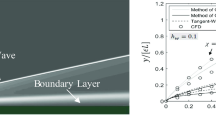Abstract
Several widely used computer programs for calculating viscous transonic flow in both two and three dimensions use a classical direct-iteration scheme to couple an inviscid-flow solution for the outer flow with a solution to boundary-layer equations for the viscous flow near the surface. In weak solutions to the inviscid-flow equations, shocks represent discontinuities that are inappropriate as input to the boundary-layer equations. In practice, however, the inviscid solutions are generated numerically, and the shock discontinuities are smeared over several grid cells. It is a common practice to feed the inviscid solution directly into the boundary-layer equations, allowing the boundary-layer solution to respond to the smeared shock jumps just as it would to any other pressure gradient. For very weak shocks the thickening of the boundary layer through the shock predicted in this way should be very nearly correct, but for stronger shocks there are three major drawbacks to this approach:
-
1)
The prediction of the viscous flow development through the shock is inaccurate because the assumptions inherent in the simple boundary-layer equations are violated in such a strong-interaction region,
-
2)
the coupled solution has an unrealistic dependence on the grid spacing used in the inviscid solution. In the real flow, the smearing of the pressure rise through the shock results from the interaction of the shock with the boundary layer, while in coupled calculations the smearing depends strongly on the grid spacing of the inviscid solution, and
-
3)
the boundary-layer solution will often predict separation for cases in which the shock is moderately strong, but in which no separation appears in the real flow.
Access this chapter
Tax calculation will be finalised at checkout
Purchases are for personal use only
Preview
Unable to display preview. Download preview PDF.
Similar content being viewed by others
References
Inger, G. R., “Some Features of a Shock-Turbulent Boundary-Layer Interaction Theory in Transonic Flow-Fields,” Computation of Viscous-Inviscid Interactions, AGARD Conference Proceedings No. 291, October, 1980.
Sirieix, M., Director, ONERA, private communication.
Bozatli, A. N., “Shock-Boundary Layer Interaction,” unpublished Boeing Report, April, 1982.
Inger, G. R., “Application of a Shock-Turbulent Boundary Layer Interaction Theory in Transonic Flow Field Analysis,” Transonic Perspective — A Critique of Transonic Flow Research, NASA Ames Research Center, February, 1981.
Yoshihara, H., and Zonars, D., “An Analysis of Pressure Distributions on Planar Supercritical Profiles with and without Jet Flaps at High Reynolds Numbers,” GDCA-ERR-1684, December, 1971.
Yu, N. J., “Transonic Flow Simulations for Complex Configurations with Surface-Fitted Grids,” AIAA Paper No. 81-1258, 1981.
Chen, H. C., Yu, N. J., and Rubbert, P. E., “Flow Simulations for General Nacelle Configurations using Euler Equations,” AIAA Paper No. 83-0539, 1983.
McLean, J. D., and Randall, J. L., “Computer Program to Calculate Three-Dimensional Boundary-Layer Flows over Wings with Wall Mass Transfer,” NASA CR-3123, May, 1979.
McLean, J. D., and Randall, J. L., “Three-Dimensional Boundary-Layer Calculations for Fuselages,” 5th U.S. — German Data Exchange Agreement Meeting on Viscous and Interacting Flow Field Effects, 1980.
Nash, J. F., and Tseng, R. R., “Three-Dimensional Turbulent Boundary Layer on an Infinite Yawed Wing,” The Aeronautical Quarterly, November, 1971.
Deane, A. E., “Reynolds Number and Shape Factor Effects on Transonic Shock-Turbulent Boundary Layer Interactions, including Incipient Separation,” M. S. Thesis, Dept. of Aerospace Engineering, Virginia Polytechnic Institute and State University, Blacksburg, Virginia, December, 1980.
Author information
Authors and Affiliations
Editor information
Editors and Affiliations
Rights and permissions
Copyright information
© 1986 Springer-Verlag Berlin, Heidelberg
About this paper
Cite this paper
McLean, J.D., Matoi, T.K. (1986). Shock/Boundary-Layer Interaction Model for Three-Dimensional Transonic Flow Calculations. In: Délery, J. (eds) Turbulent Shear-Layer/Shock-Wave Interactions. International Union of Theoretical and Applied Mechanics. Springer, Berlin, Heidelberg. https://doi.org/10.1007/978-3-642-82770-9_25
Download citation
DOI: https://doi.org/10.1007/978-3-642-82770-9_25
Publisher Name: Springer, Berlin, Heidelberg
Print ISBN: 978-3-642-82772-3
Online ISBN: 978-3-642-82770-9
eBook Packages: Springer Book Archive




